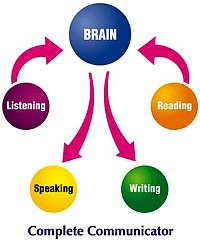 |
Learn English Locally, Apply It Worldwide! Enjoy Regular Practice |
Learning Chinese - Would You Dare?
Today, out of the blue altogether, I was gifted a big English-Chinese and Chinese-English dictionary. I've been learning Chinese from the very beginning of my stay in Donghai, sometimes with a teacher, other times on my own, from various books and from the Internet, but I must admit it's going very slowly. In case you wonder... it's not so much because it's that difficult, but rather due to my lack of discipline in practising it every day, as I often preach about learning English. So, today would be a good starting point for this subject - hopefully it'll turn out to be a good motivator.
Here is an introduction to the history of Chinese calligraphy. It's not an original story, but I decided to share it here with you for two reasons: it's short and accurate and it gives a good indication of the level of English the Chinese learn in grade 10. This is only half of an exercise for designing a booklet - the other article was on the Braille tactile writing system. The girl who lent me her books (age 16) told me how they start their classes at 7:30am and go home to sleep at 10pm, with a lunch break of 2 hours... every day!! When I showed my amazement she admitted that ... well, once a month they're allowed a break of 4 hours on a Sunday afternoon, but after that they need to return to school to finish their scheduled classes.
The Development of Chinese Characters
The Chinese language differs from Western languages in that, instead of an alphabet, it uses characters which stand for ideas, objects or deeds. Chinese words are formed by putting together different characters. In many cases, a single character can also make up a word. The history of the Chinese language can be examined by looking at how these characters developed.
Chinese writing began thousands of years ago. According to an ancient story, a man named Cang Jie invented Chinese writing. One winter day while he was hunting, he saw the tracks of animals in the snow and observed that the appearance of each one was different. Then he had the idea that he could use different shapes to represent different objects. The first Chinese characters were drawings of physical objects. Some characters have been simplified and others have been made more difficult over time. However, as a whole, the characters have developed from drawings into standard forms. The character for a mountain was at first three mountaintops together. This became one mountaintop and three lines, and over time turned into the character used nowadays.
Not all characters were developed from drawings of objects. Sometimes to express ideas, some characters were made by combining two or more characters together. For example, ‘rest’ was made up of the characters for a man and a tree. The character ‘prisoner’ was formed with a ‘man’ inside a square. Other characters were developed for directions and numbers. It is easy to distinguish their meaning by looking at them, for example, the characters for ‘up’ and ‘down’, which are opposites of each other.
Though these kinds of characters indicate meanings, one of their shortcomings is that they do not show how they should be pronounced. Therefore, a method was developed to have one part of a character indicates the meaning and the other suggests the pronunciation. Many Chinese characters used today were made this way.
In the 1950s the Chinese government introduced simplified Chinese characters and now they have widespread use in China’s mainland.
English Corner Weekly E-zine
Packed with knowledge, published on Tuesdays.
Get yours here!
Our Archives:
Our lessons in the names and sounds of letters, short & long vowel sounds, CVCs, CCVCs, CVCCs, sight words, vowel and consonant contrasts, etc.
Our lessons will help increase your vocabulary, word recognition, find meaning in context, skills for TOEFL tests and other games, for fun.
Here we shall build some lessons to help you improve your writing skills.
Lots of lessons: cause & effect, comparisons, linking signals, relative clauses, presenting information, expressing emotions and grammar games, of course. We had more lessons on: intensifying adverbs and phrasal verbs, expressing various concepts such as addition, exception, restriction and ambiguity. Lately we started some exercises: likes/dislikes, frequency adverbs (twice), verb tenses, etc.
Learn how to build a website, by using the SBI! system - start from the basics, developing a site concept and a niche, supply and demand, learn about profitability and monetization, payment processing, register domain, website structure and content as a pyramid. Also learn about the tools I'm using to build this website. We also covered how to build traffic, working with search engines, building a good system of inbound links, using social marketing and blogs with the SBI system, how to use Socialize It and Form Build It, how to publish an e-zine and how to build a social network in your niche.
We looked at a few games by now: Countable & uncountable nouns, Free Rice, Name That Thing, Spell It, Spelloween, the Phrasal Verbs Game, Preposition Desert, The Sentence Game, Word Confusion, Word Wangling, Buzzing Bees, and The Verb Viper Game.
Be prepared to play and learn more pretty soon.
